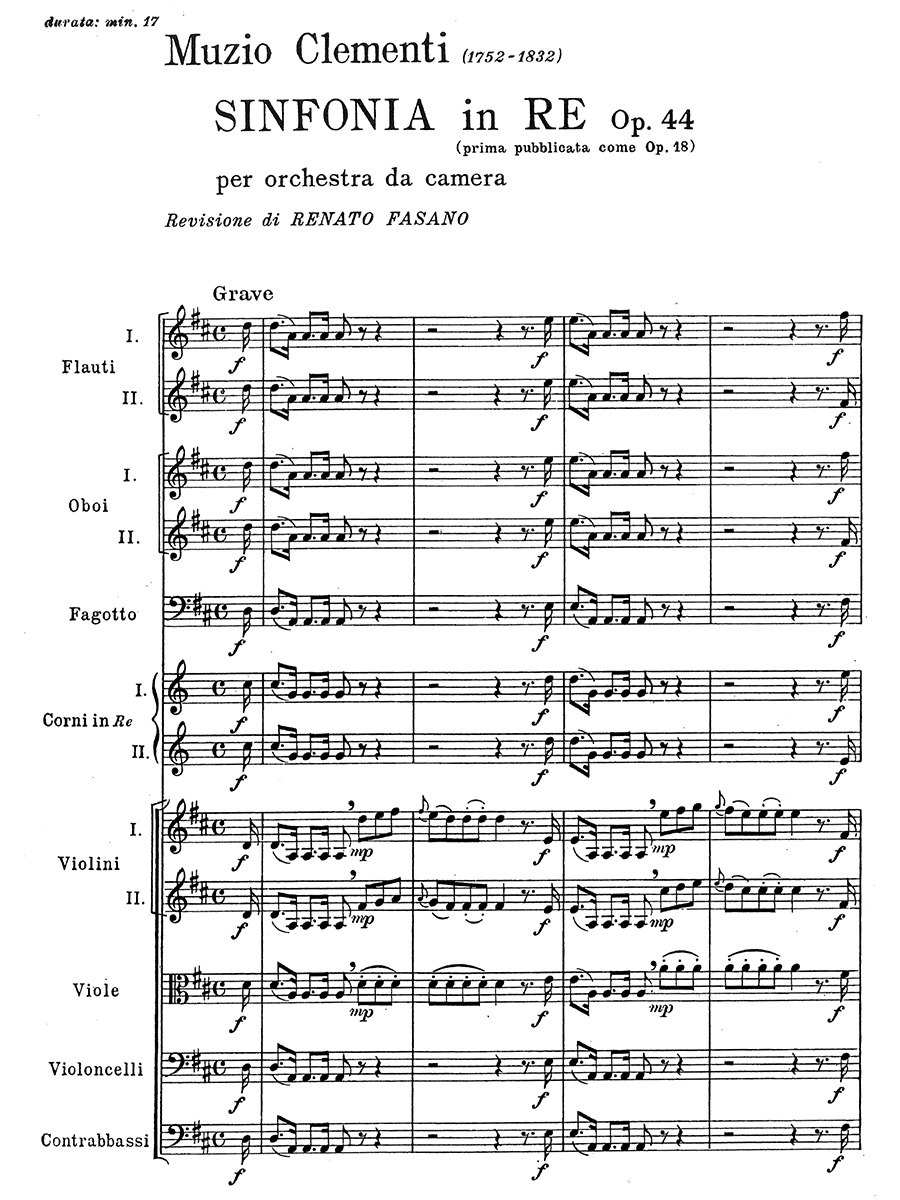Sinfonia in Re Op. 18, no. 2
Clementi, Muzio
19,00 €
Preface
Muzio Clementi
Sinfonia in Re, Op. 18, no. 2
(b. Rome, Italy 1752– d. Evesham, Worschester, England 1832)
Preface
Muzio Clementi was born in Rome, Italy and began his musical studies at a young age. At the age of 13 he began working as the organist for S. Lorenzo in Damaso church in Rome. His abilities soon attracted the attention of Peter Beckford (1740–1811) an Englishman making the Grand Tour. Beckford contracted with Clementi’s father for Clementi to provide musical entertainment at Beckford’s country estate, Stepleton Iwerne in Dorset, until Clementi’s twenty-first birthday. Around 1774 Clementi moved to London where he lived and worked as a composer, virtuosic pianist, conductor, music publisher, as well as owner and manager of a piano manufacturing and sales business. Although most well-known for his piano compositions, Clementi spent a number of years composing and performing symphonies in London and various cities in Europe. Of the estimated 20 symphonies Clementi composed, most are now lost, and the Sinfonia in Re, Op. 18, no. 2 is one of only two that were published during his lifetime.
In 1786 Clementi began his public appearances as a symphonist, presenting symphonies on more than half the concerts in the Hanover Square Grand Professional Concert series, of which he was the principal composer and performer that year. The Morning Herald on February 23, 1786 declared, “The scientific Clementi produced a brilliant overture, full of ingenious modulation.” At least one scholar has posited the review may relate to the Symphony in D, Op. 18, no. 2. This symphony is representative of the hopefulness generally associated with the eighteenth century. Though there are darker moments of tension, they always resolve into sprightly brightness that is clearly joyful. Clementi’s biographer, Leon Plantinga, notes a turn in Clementi’s compositional style in the early 1780s away from the virtuosic towards a more melodic and noble style of composition. This focus can be seen to persist in this symphony. The score calls for a relatively small force of players and is not virtuosic in its demands, making it equally suitable for private music making by amateur musicians. As private amateur performances were a common past-time, this may have been Clementi’s motivation for publishing this symphony and the underlying cause of its preservation.
This light and playful symphony adheres to the galant aesthetic of clear melodies and clean lines, with the string section leading and the winds generally providing color or echoing the thematic material. It is in four movements, as was standard for much of continental Europe at the time, but still relatively new among English composers. The first movement begins with a slow Grave introduction, which moves into an allegro that is stately, yet playful in its figures that combine legato and staccato articulations. The Andante movement is dominated by the strings and maintains the character of the lighter portions of the first movement. The third movement is a bold minuet. The final movement is the fastest, Allegro Assai, which provides a driving and ebullient conclusion to the symphony.
Clementi’s Op. 18, no. 1 and 2 was published in London by Longman and Broderip and entered at Stationer’s Hall on April 23, 1787 as “No. 1 & 2, Symphonie á Grand Orchestre composée par Muzio Clementi.” Unfortunately, there are no extant manuscripts of the symphony.
Joyce Asber, 2016
For performance material please contact the publisher Ricordi, Milano. Reprint of a copy from the Musikbibliothek der Münchner Stadtbibliothek, Munich.
Score Data
| Edition | Repertoire Explorer |
|---|---|
| Genre | Orchestra |
| Size | 210 x 297 mm |
| Printing | Reprint |
| Pages | 60 |
